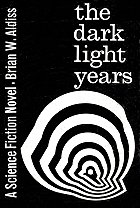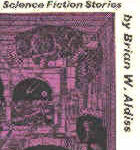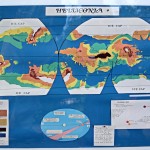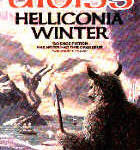Dapdorf — Helliconia — Earth
Brian W. Aldiss on World-Views and Technology in The Dark Light Years and the Helliconia Trilogy
by Richard D. Erlich
I once asked a colleague knowledgeable about films to explain to me, very briefly and simply, auteur theory, and he responded that the upshot was that if film directors have any authority at all over their films they’ll tend to repeat themselves from film to film, and repeat themselves with sufficient consistency that the critics can find patterns–especially thematic patterns–in the film-makers’ works. “That’s it?” I said, “That’s hardly news to Shakespeare critics.”
“That’s it,” he said more or less–and implied that artists’ having sustained interests shouldn’t be news to anyone.
Brian W. Aldiss has some strongly sustained interests, and those interests have been elucidated in the Aldiss Unbound pamphlet by Richard Mathews and discussed in detail by Brian Griffin and David Wingrove in Apertures, a book-length “Study of the Writings of Brian W. Aldiss.” So my choice of The Dark Light Years and the Helliconia trilogy for an exercise in comparison and contrast is necessarily a little arbitrary, and the exercise itself would be derivative if I weren’t so far behind in my reading of critical studies.
I’ll defend my choice in terms of preference and perversity. The preference is that I really like The Dark Light Years and have wanted to talk about it for a long time. The perversity lies in the fact that the differences between The Dark Light Years and the Helliconia trilogy are not only obvious but also very great.
The Dark Dight-Years, is short, satiric, and early (1964); the Helliconia trilogy is long, Romance-Epical, and just completed (1982-85). Aldiss himself claims in a letter to have “never thought of it that way”–of similarities between The Dark Light Years and the Helliconia trilogy, and Aldiss finds close parallels with Gallaxies Like Grains of Sand. Indeed, there are assatassi fish in both Helliconia and Galaxies and, more seriously, what Aldiss identifies as “parallels of scope” . And Griffin and Wingrove state explicitly that “. . . just about every idea, in just about every subsequent book by Aldiss, can be found, in embryonic form, in Galaxies Like Grains of Sand” . Richard Mathews finds Space, Time and Nathaniel, with which I’m not familiar, the short-story collection where Aldiss “established the terrain he will explore” . Additionally, much in Helliconia will be familiar to readers of Aldiss’ Hothouse, Greybeard, and Non-Stop .
Still, both The Dark Light Years and the Helliconia trilogy employ the conceit of a planet with a lost moon and more than one sun (three for Dapdorf in The Dark Light Years, two for Helliconia), and with a Great Year that involves severe climatic changes. Both works assume a universe relatively devoid of life ; both works juxtapose high-technology and low-technology civilizations; both deal with dangerous innocence ; both feature important religions; both works have an “Avernus” and the idea of unwelt, the “external-world-plus-senses” . And both works are meditations upon world-views and how those world-views influence technology and, more generally, the development of cultures.
Helliconian technology in the trilogy never gets beyond gas lights and the revolver, but its rise in the Great Year covered is observed on “Earth Observation Station Avernus” and, via transmissions from the Avernus, on Earth. And the Avernus is very high-tech–as is Earth before our nuclear winter and ice age. In The Dark Light-Years, the alien utods are, when we see them, peaceful and comparatively low-tech; humankind in The Dark Light Years are high-tech and vicious–“Homo sap” as we know him in satire, in one of his nastier incarnations. The antitheses, reversals, and multiple points of view in both works allow Aldiss to comment profoundly on technology and the myths and passions that lie behind technology.
Aldiss makes these points in such different works as The Dark Light Years and the Helliconia trilogy, works separated by some twenty-five years; and I find this repetition a very rigorous proof of Aldiss’ abiding concern if not with technology as such then with the problematic nature of the world-views–and the civilization itself–that produce technology and are in turn produced by technology and technique.
I
The plot of The Dark Light Years is easy to summarize. “Somewhere in time” (the near future) and “somewhere in space” (relatively nearby by galactic standards–on a planet the utods call “Mistake”), Anglo-American “man and” alien utod meet “face to face.” And, with Aldiss’ inspiration being more Jonathan Swift and Joseph Conrad than James Thurber, our boys waste no time wasting the beasts, except for two they take back to Earth for a sample. The two aliens are cleaned up, put in the London Exozoo, and studied, eventually studied by vivisection without anesthetic to see if utods really are impervious to pain. (The “Contained Conflict” between England and Brazil on “The Deep Freeze Planet,” Charon , isn’t going well, and the British authorities believe that making their soldiers impervious to pain might help the war effort .) An expedition is mounted to find the utods’ home planet, Dapdorf; and the Terrans soon find Dapdorf and leave there one automated telemetry station, one Alymer Ainson (a human observer ordered to learn to communicate with the utods), and one substantial arsenel. Alymer gets stranded on Dapdorf for some forty years when the Anglo-Brazilian “Contained Conflict,” limited war on Charon expands to Earth, our colony worlds (including those of the utods), and into a limited Apocalypse . Alymer is picked up, and The Dark Light Years ends with Ainson’s utod friend checking out the armory; and, knowing that he’ll soon metamorphose into an even more robust utodian form, the utod thinks it time “. . . he thought about freedom. Time, too that the rest of his brothers thought about freedom” . Since the utods can produce even space ships as “a cottage industry” , humans are in trouble.
The vast scheme of the Helliconia trilogy can be summarized even more quickly. Helliconia Spring begins around the time of the spring solstice and ends at the vernal equinox; Helliconia Summer covers the summer; and Helliconia Winter ends with the winter solstice–all seasonal events referring to the Helliconian Great year of 1825 Helliconian small years, some 2600 of our years. Since Helliconian civilization rises and declines with the seasons, the trilogy covers the rebirth of Helliconian civilization in the spring of the Great Year to its apex–this cycle–in the northern continent of Sibornal “The Day of Myrkwyr . . . the harbinger of Weyr-Winter ahead”.
II
Part of the fun of The Dark Light Years is Aldiss’ variation in it of the standard satiric technique of reductio ad excrementum, or reducing something–usually an opponent–to shit. But shit’s a relatively good thing in The Dark Light Years, or, at least, the utods are metaphorically “into” as well as literally in shit: their historical experience has led them to have serious qualms about hygiene, and they like to wallow in a muck that includes their own excrement. That’s a problem for human understanding of and feeling with the utods; as Sir Mihaly Pasztor says, “To our way of thought . . . civilization is reckoned as the distance man has placed between himself and his excreta” . The statement is made more exact and more general a bit later when Sir Mihaly recalls that epigram he had “trotted forth too often” and adds a “But”: “But it was nearer the truth to say that civilization was the distance man had placed between himself and everything else . . . .” Central to civilization as we know it is the invention of barriers .
At the very beginning of the Helliconia trilogy, we don’t see much by way of barriers, but, then, we see no civilization. The “Prelude” to Helliconia Spring begins on an icy plain with two more or less savage humans. The older human is captured and enslaved by phagors, double-horned humanoids, who predate the evolution of humans on Helliconia; the younger, the eventual culture-Hero Yuli, goes to the closest thing around to civilization: the underground city of Pannoval. Pannoval puts rock and earth between itself and the cold, and the people of Pannoval are far enough from savage equality to establish “labyrinthine” laws and to separate themselves into hierarchies and castes–social, religious, and military . Some barriers, then, but few by our standards.
The Helliconia trilogy moves from the equatorial regions of Pannoval and Oldorando in Helliconia Spring to the southern reaches of civilization in Helliconia Summer, ultimately, in Helliconia Winter, to Sibornal, at the northern polar circle: to the site of the Great Wheel of Kharnabhar, the greatest achievement–in an earlier cycle–of Helliconian science and technology. The cultures that we see move from the crudest sort of subHelliconian city to something like American culture in the early 19th century: sophisticated enough to have invented revolvers, effective bureaucracy, and imperialism, yet primitive enough to still have slaves.
For someone familiar with The Dark Light Years, the hope might be that the Helliconians won’t get much into walls and barriers, that their climatic cycles might keep them free of what Mrs. Hilary Warhoon thinks of in The Dark Light Years as “simian male superiority” and be, as Mrs. Warhoon sees women, not “cut off from the basic realities of life” . My hope, anyway was that the Helliconian humans might become like the utods, whom Mrs. Warhoon correctly interprets as “a civilized race that had come to its maturity by a very different path from man’s. For this race from the start and continuously (or without more than a brief intermission)”–and the utods did have their “brief intermission” of an industrial revolution –“had never been in conflict with nature . . . . [A species that] had remained in rapport, undivorced” .
Aldiss’ response to that hope is a Steve Martinian “Naaahhh” or John Belushian “But noooo!” A very sophisticated Helliconian like SartoriIrvrash can desire to “build up bulwarks against nature” and then recognize the futility of doing so and speculate that “Perhaps our mistake is to think of ourselves apart from nature” . Still, most of the politically powerful humans on Helliconia stick close to the Terran model for urban civilization; and survival’s requirement for mutual aid leads their most highly developed nation to pay the price that Lewis Mumford says our ancestors paid for our urban utopias: “total submission to a central authority, forced labor” for all except the elite, “lifetime specialization, inflexible regimentation, one-way communication, and readiness for war” .
At the end of the Helliconia trilogy, Sibornal goes into deep winter under the firm control of an Oligarchy intent on totalitarian control, world conquest the following spring, and the erradication of both phagors and the plague they carry. Moreover, the Oligarchy undertake the extermination/public hygiene campaign well aware that “the real workings” of the plagues has been to ensure an “enantiodromic” (mirror-reversal) survival for both phagors and humankind . That “Shiva of diseases, that destroyer and saviour, carried on its bloodied sword survival for mankind in the extravagant conditions of the planet. . . . It was the price of survival, of their continued development. From the carnage . . . a reassurance rose from the deepest springs of being to murmur that all was ineffably well. Only those who could believe would believe such reassurance” .
The Oligarchs do not accept such reassurance. The guess we get for their motivation is that the Oligarch, singular, “knew that killing off all phagors meant ultimately killing the humans–yet still he passed his orders” as “An act of defiance,” which, we’re told is “mankind’s nature.” The maker of that statement thinks “Nature will take care of us”, and it’s with an act of defiance that he ends Helliconia Winter and the trilogy. Instead of marrying his loyal former slave and mother of his son and giving an upbeat, romantic-comic ending to the trilogy, he rides off on his yelk yelling defiance: “Abro Hakmo Astab!”–the forbidden curse.
III
If Northrop Frye is correct in seeing tragedy as “The Mythos of Autumn” , then there’s decorum in Aldiss’ closing Helliconia Winter and the trilogy with defiance, individuality, and alienation. There’s certainly precedent: from Sir Thomas Malory’s ending the Romance of the Round Table by slipping into tragedy and the death of Arthur to the endings of Helliconia Spring and Helliconia Summer, where Aldiss in each case has phagors burn down much of the now-human city of Oldorando, though moderating the tragedy of Oldorando with promises of new human connection and unity. There’s also a precedent of sorts in Aldiss’ ending of The Dark Light Years: it looks forward to a “hard period” of an “entropic solar orbital displacement” when the utod Snok Snok will “need to be male and fierce and tough” . Snok Snok is the utod looking into the armory at story’s end, and the hard times for Snok Snok will be even harder for humans. The satire of The Dark Light Years may come to an esthetically satisfying conclusion by moving toward tragedy for humans, and a dark comedy for utods.
The ending of the Helliconia trilogy, however, is more complex than I’ve implied. The Dark Light Years has its three main locales on Grudgrodd (in English, “Mistake”), Dapdorf, and Earth; so, too, the Helliconia trilogy has two locales in addition to Helliconia.
The planet Helliconia revolves around the star Batalix, and both together revolve around the star Freyr; but in addition “the Earth Observatory Station Avernus” revolves around Helliconia and through its equipment monitors the entire system. The Avernus transmits its data to Charon, from whence it goes to Earth (taking all told 1000 years). So, in reading the trilogy we, through the Narrator, can observe the people of Earth observing Helliconia as monitored by Avernus.
Concentrating on the hero of Helliconia Winter, Luterin Shokerandit (and no book of the trilogy concentrates on a character more than Helliconia Winter concentrates on Luterin)–concentrating on the individual and taking the short view, Helliconia Winter moves into tragedy. But perhaps “Nature will take care” of them and the Oligarchy will fail in its plans–and, perhaps, humanity on Helliconia will experience the spring rebirth.
Perhaps. More certainly, any tragedy on Helliconia is contained within a larger form, within, indeed, a series of larger forms: Helliconian sentience, Helliconia itself; the system of Helliconia and Avernus; the triple worlds of Helliconia, Avernus, Earth. Northrop Frye says that “. . . comedy can contain a potential tragedy in itself” , and in so vast a structure as the Helliconia trilogy the tragedy can go from potential to actual.
Shortly before Luterin Shokerandit makes his defiant exit to close the trilogy, we learn that “the Avernus stops” (to modify a title from E. M. Forster). Like the Great Wheel of Kharnabhar, the Avernus “also relied on faith for its workings,” and “That faith had failed”; the humans on Avernus had failed, and soon the machines would also. Cut off from Nature with a vengeance, the families on the Avernus go mad: “. . .a revulsion from all things mechanical or technological had left the tribes prey to a spiritless eudaemonism in which the sexual motif predominated. * * * Gradually a general disintegration took place, as if the genetic coding on which inheritance depended had itself became confused” . In a controlling image of Helliconia Winter, we have a mirror reversal: the hyperintellectual, hyperrational, total-technique world of Avernus reverts to savagery.
But this tragedy, too, is within a larger comic scheme. Or, tragicomic. Interspersed with the story of Helliconia we get not only the story of the Avernus but also the story of Earth; and the children of Earth, after a Nuclear Winter rivaling Helliconia’s great winter, come–finally–to a recognition of our place in the universe and can end the separation between us “and everything else” . After centuries of of watching Helliconia and now seeing ourselves as part of Gaia, Mother Earth, we gain a new umwelt. We learn what we needed in The Dark Light Years: “a new way of feeling” , “another idea of civilization, built on a sympathy for, an empathy with, all other living things” .
In The Dark Light Years, a minor character offers comfort to a rattled Sir Mihaly Pasztor by telling him that we humans are “coming away from the mud, away from the primeval slime, away from the animal, towards the spiritual.” Since what’s rattled Pasztor is the death by torture of one of the utods, we sympathize when he asks “Oughtn’t we to have stayed in the mud? Mightn’t it be more healthy and sane down there?” . In the satiric world of The Dark Light Years, we’d be better off to have stayed in the mud. In the Helliconia trilogy, we’d better stay out of totally mechanized environments, and the Helliconian humans will need a lot of luck if Nature is to save them; for Earth’s people, though, there’s a happy ending: becoming “a focus of consciousness for the whole biosphere,” linking Gaia, “the biospheric gestalt” of Earth, with “the Original Beholder” of Helliconia . In the comic aspect of the trilogy, we’ve come “away from the mud” but have regained touch with Gaia. We no longer consider ourselves “the centre of things, Lords of Creation” . In the formulation of The Dark Light Years, we no longer believe “that matter is there to be manipulated” –or only manipulated; we no longer believe that the universe exists to be conquered through human technology and technique.
But Aldiss hasn’t gone soft on us since The Dark Light Years. The last words we hear in the Helliconia trilogy from post-technological, non-urban, uncivilized, paradisal Earth are spoken by a philosopher who’s “named himself after a dangerous old sage who once lived on Helliconia” : “With the deepest respect to Gaia and her Serpent-Bearing sister out there,” the Original Beholder–“they are old biddies at times. Mankind learned aggression in their wombs” .
It is well that Terran humans have overcome fear, possessiveness, aggression and have given up “The ancient dreams of power” . Aldiss reminds, us, though, even in the comic aspects of the Helliconia trilogy, that our nastier aspects are birthrights. After we Terrans have a Helliconia to study and after we survive nuclear winter and near-total destruction, then in the Helliconia trilogy we learn the proper human relationship to technology. Can we in the nonfictional world learn such a lesson? Perhaps.
* * *
Sources
Aldiss, Brian W. The Dark Light Years. 1964. New York: NAL, 1964. Cited as DLY.
—. THE HELLICONIA TRILOGY. New York: Atheneum.
Helliconia Spring: 1982. Cited with a Roman I.
Helliconia Summer: 1983. Cited with a Roman II.
Helliconia Winter: 1985. Cited with a Roman III.
I have used the Science Fiction Book Club editions.
—. Galaxies Like Grains of Sand (vt. The Canopy of Time). New York: NAL, 1960. [See Griffin and Wingrove 27-28 for biblio. data on Galaxies and Canopy.]
—. Letter to the author. 5 November 1985.
—. Space, Time and Nathaniel (vt. No Time Like Tomorrow). London: Faber, [1957].
—. “Up Against the Universe.” Foundation #20 (October 1980): 9-15.
* * *
Frye, Northrop. Anatomy of Criticism. 1957. New York: Atheneum, 1966.
Goddess of the Earth. Written and Produced by John Groum. BBC Television, 1985. First US showing, NOVA, 28 January 1986, in a form copyrighted 1986 by WGBH Educational Foundation. [Based on “the Gaia hypothesis” presented by James Lovelock in Gaia: A New Look at Life on Earth (use of hypothesis acknowledged by Aldiss in end matter of Helliconia Winter).]
Griffin, Brian. “Moving Towards Chaos: Aldiss’s Hothouse.” Foundation #20 (October 1980): 15-27. Cited as “Griffin.”
Griffin, Brian, and David Wingrove. Apertures: A Study of the Writings of Brian W. Aldiss. Westport, CT, and London: Greenwood, 1984. Cited as Griffin & Wingrove.
Mathews, Richard. Aldiss Unbound: The Science Fiction of Brian W. Aldiss. San Bernardino, CA: Borgo Press, 1977. Vol. 9 in the Milford Series, Popluar Writers of Today.
Mumford, Lewis. “Utopia, The City, and The Machine.” Utopias and Utopian Thought. Ed. Frank E. Manuel. Cambridge, MA, and Boston: Riverside & Houghton Mifflin, 1966, pp. 3-24.
Wolfe, Gary K. The Unkown and the Unknown: The Iconography of Science Fiction.
Kent, OH: Kent State U P, 1979. (pp. 66-7)
* * *
This paper was first delivered at The Seventh Annual International Conference for the Fantastic in the Arts. Houston, TX, 12-16 March 1986. Copyright © 1986. Richard D. Erlich
* * *
ABOUT THE CRITIC: Richard D. Erlich is a professor in English at Miami University in Oxford, Ohio, where he regularly teaches courses in Shakespeare, Shakespeare and film, science fiction, science-fiction film, early English literature, and writing; in 2000-2001, he will teach a course in Satire as mode and genre. In collaboration with Thomas P. Dunn, he edited the Greenwood Press anthologies The Mechanical God: Machines in Science Fiction (1982) and Clockwork Worlds: Mechanized Environments in SF (1983); with Dunn and others he compiled Clockworks: A Multimedia Bibliography of Works Useful for the Study of the Human/Machine Interface in SF (Greenwood, 1993). Alone and in collaboration, he has published articles on the usefulness and “Necessary Uncertainty of Historical Criticism”; D. H. Lawrence’s Women in Love; 2001: A Space Odyssey as film and novel, and other works by A. C. Clarke; the fantasy and SF of Ursula K. Le Guin; major satires by Frederik Pohl and C. M. Kornbluth; post-holocaust films, mechanical and insectoid imagery in SF; Larry Niven and Jerry Pournelle’s Oath of Fealty; and Outsiders in Shakespeare’s history plays, some dystopian SF, and Animal House. His print-sf website is http://www.geocities.com/courseinsf, Coyote’s Song: The Teaching Stories of Ursula K. Le Guin, an extensive close rea





